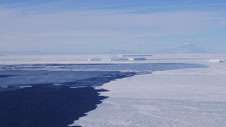Researchers devise new way to monitor 'health' of ice shelves

Studying an exotic form of sea ice known as platelet ice has enabled a University of Otago-led international research team to construct a century-long record of the condition of Antarctica's Ross Ice Shelf.
The first-of-its-kind dataset indicates that over the past century this major ice shelf has remained largely stable in contrast with shelves in other parts of Antarctica. In recent decades several shelves have been thinning from below and collapsing, likely due in part to warmer water temperatures.
The researchers, led by Otago Physics Associate Professor Pat Langhorne, have also been able to establish a continent-wide baseline for melt-refreeze processes at the bases of Antarctic ice shelves so that future change may be measured. Their methods and data are published in the international journal Geophysical Research Letters.
Instead of directly measuring the ice shelves, the team studied a signature in sea ice cores taken from the frozen ocean that surrounds the continent in winter. This signature revolves around the presence or absence of platelet ice, which grows at the base of sea ice when super-cooled seawater flows out from under the shelves and into the surrounding ocean.
Associate Professor Langhorne says melting at depth and refreezing in the shallower parts of an ice shelf is a natural process that has taken place over millennia.
"In many places, this very cold seawater— which is on the point of refreezing—flows out from under the ice shelf to the bottom of coastal sea ice. The platelet ice this forms reflects lower temperatures at the base of the shelf which prevent its thinning."
Being able to monitor the 'health' of the bases of Antarctic ice shelves is vital because the shelves act as 'corks' that keep the ice on continental Antarctica from flowing into the ocean and catastrophically raising global sea levels, she says.
"Once ice shelves collapse, there can be a dramatic increase in the rate at which ice flows into the ocean. The need for better understanding and monitoring of ice shelf basal processes is urgent and our work is helping to provide this."
More information: "Observed platelet ice distributions in Antarctic sea ice: An index for ocean-ice shelf heat flux," Geophys. Res. Lett., 42, DOI: 10.1002/2015GL064508.
Journal information: Geophysical Research Letters
Provided by University of Otago



















